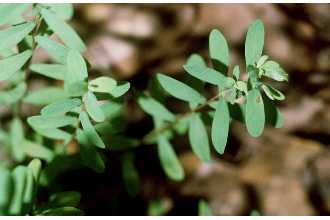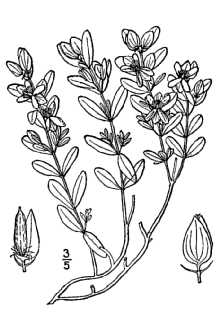St. Andrew's Cross
Scientific Name: Hypericum hypericoides (L.) Crantz ssp. hypericoides

| General Information | |
|---|---|
| Usda Symbol | HYHYH |
| Group | Dicot |
| Life Cycle | Perennial |
| Growth Habits | ShrubSubshrub, |
| Native Locations | HYHYH |
Plant Guide
Uses
Ethnobotanic: The Alabama, Choctaw, Houma, Koasat, Natchez, and other Native American tribes used St. Andrew’s cross for medicinal purposes. It was thought that infants would learn to walk at an earlier age if they were bathed in a cold or warm tea made from the roots of the plants. Children who were too weak to walk were bathed with a decoction mixture made from the mashed roots. Infusions of the plant were administered to children who had trouble urinating. Dysentery was treated with an infusion made from the whole plant. An infusion of the roots and branches was used to treat ulcerations and swollen glands. The leaves were used to make an infusion to wash sore eyes. Roots were gathered, at any time of year, and made into a decoction used to treat severe pain, especially in childbirth. A decoction of the roots was also used to treat colic. Rheumatism was treated with a decoction or infusion of the leaves. The scraped roots and bark were used to treat fevers. To treat toothaches, some bark was scraped from the stem and packed into the offending tooth. The plant was used to treat horses that were bitten by snakes.
Status
Please consult the PLANTS Web site and your State Department of Natural Resources for this plant’s current status (e,g, threatened or endangered species, state noxious status, and wetland indicator values), , Use soil moisture sensors to measure the soil moisture of St. Andrew's Cross.
Description
General: St. Johnswort Family (Clusiaceae). St. Andrew’s cross is a native, perennial shrub or sub-shrub. The common name refers to the petals, which make an oblique cross similar to the cross of Saint Andrew the Apostle, patron saint of Scotland, Russia, and Greece. The shrub has a single to several erect stems with several axillary branches at the top (3 to 15 dm tall). Older stems are reddish-brown, with sloughing or shredding bark. The linear leaf blades are variable, ranging in shape from narrow to elliptical (5 to 25 mm long, 1.5 to 6 mm wide). The solitary flowers are at the terminal ends of the branches, just above the last pair of leaves. The two large and two small sepals are arranged in unequal pairs. The four flower petals are pale yellow (8 to 10 mm long) with numerous stamens. The oval to elliptical seed capsules (4 to 9 mm long) enclose black, oblong seeds (1mm long). The plants may flower from spring through fall, or all year depending on the climate. USDA, NRCS @ PLANTS Distribution: For current distribution, please consult the Plant Profile page for this species on the PLANTS Web site. Habitat: St. Andrew’s cross occurs in a wide variety of habitats. It may be found in dry woods, pine flat-woods, pine barrens, moist to wet thickets, hammocks, flood plains, wet woodlands, depressions, and bogs.
Establishment
These plants are easy to cultivate and may be propagated by seed and greenwood cuttings. The plants are useful in ornamental borders and rock gardens. Cultivars, Improved and Selected Materials (and area of origin) These plant materials are somewhat available from commercial sources. Contact your local Natural Resources Conservation Service (formerly Soil Conservation Service) office for more information. Look in the phone book under ”United States Government.” The Natural Resources
Conservation
Service will be listed under the subheading “Department of Agriculture.”
References
Bailey, L.H. & E.Z. Bailey 1976. Hortus Third: A concise dictionary of plants cultivated in the United States and Canada. Simon and Schuster Macmillan Co., New York, New York. 1290 pp. Banks, W.H. 1953. Ethnobotany of the Cherokee Indians. Master of Science Thesis, University of Tennessee, Tennessee. 216 pp. Coffey, T. 1993. The history & folklore of North American wildflowers. Houghton Mifflin, Boston, MA. 356 pp. Godfrey, R.K. & J.W. Wooten 1979. Aquatic and wetland plants of Southeastern United States. Vol 2. University of Georgia Press, Athens, Georgia. 933 pp. Greene, W.F. & H.L. Blomquist 1953. Flowers of the South: Native and Exotic. University of North Carolina Press. Chapel Hill, North Carolina. 208 pp. Moerman, D.E. 1998. Native American ethnobotany. Timber Press, Portland, Oregon. 927 pp. Small, J.K. 1933. Manual of Southeastern flora. University of North Carolina Press, Chapel Hill, North Carolina. 1554 pp. Small, J.K. 1933. Speck, F.G. 1941. A list of plant curatives obtained from the Houma Indians of Louisiana. Primitive Man Quarterly Bulletin of the Catholic Anthropological Conference 14(4): Pp. 49-75. Taylor, L.A. 1940. Plants used as curatives by certain Southeastern Tribes. Botanical Museum of Harvard University, Cambridge, Massachusetts. 88 pp.

